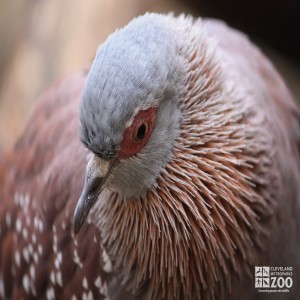Speckled Pigeon
[Columba guinea]

The Speckled Pigeon is about the size of an ordinary street pigeon, but its longer bill makes it look more slender. The mantle and wing coverts are a dark, pink-reddish purple, and the outer wing coverts are bluish-gray. There are rows of white triangles across the wings. The tail is blackish. There is a broad collar of bifurcated feathers encircling the neck. These feathers are chestnut at the base, and become silvery-green or silvery-pink at the tip. The rest of the plumage is a bluish-gray. There is a bare patch of purple skin around the eye. The feet and legs are salmon colored, and the bill is black with a white base. The juvenile is much duller with ill-defined wing spots, dull unbifurcated neck feathers, and dull grayish feet and orbital skin.
Location: Animals Formerly at Zoo
Share:
Range
The Speckled Pigeon's range is Ethiopia to South Africa.
Habitat
Speckled Pigeons inhabit open country and cultivated regions, avoiding forests.
Conservation Status
Least ConcernPrimary Threats
Gestation
Incubation: 16 days
Litter
Clutch: 2 white eggs
Behavior
The speckled pigeon is a ground feeder. It feeds largely on seeds, including cultivated grains. They are fond of groundnuts when these are available on or near the surface after harvesting. They are usually found in pairs, singly, or small parties, but large numbers may congregate at good feeding grounds. They sometimes form large and cohesive flocks when not breeding. This flocking habit seems to be more common in South Africa than in the northern part of the range. Flight is direct and fast, with strong wing beats. They walk and run nimbly on the ground. There are several different vocalizations.
Reproduction
Speckled Pigeons nest in cavities at the base of the leaves of Borassus palms, in holes in trees, and in holes or on sheltered ledges of cliffs or buildings. In parts of Uganda they regularly nest in mine shafts. The young fledge at from 20 to 25 days, depending on location.
Wild Diet
Seeds, grain
Zoo Diet
Rice, insectivorous diet
